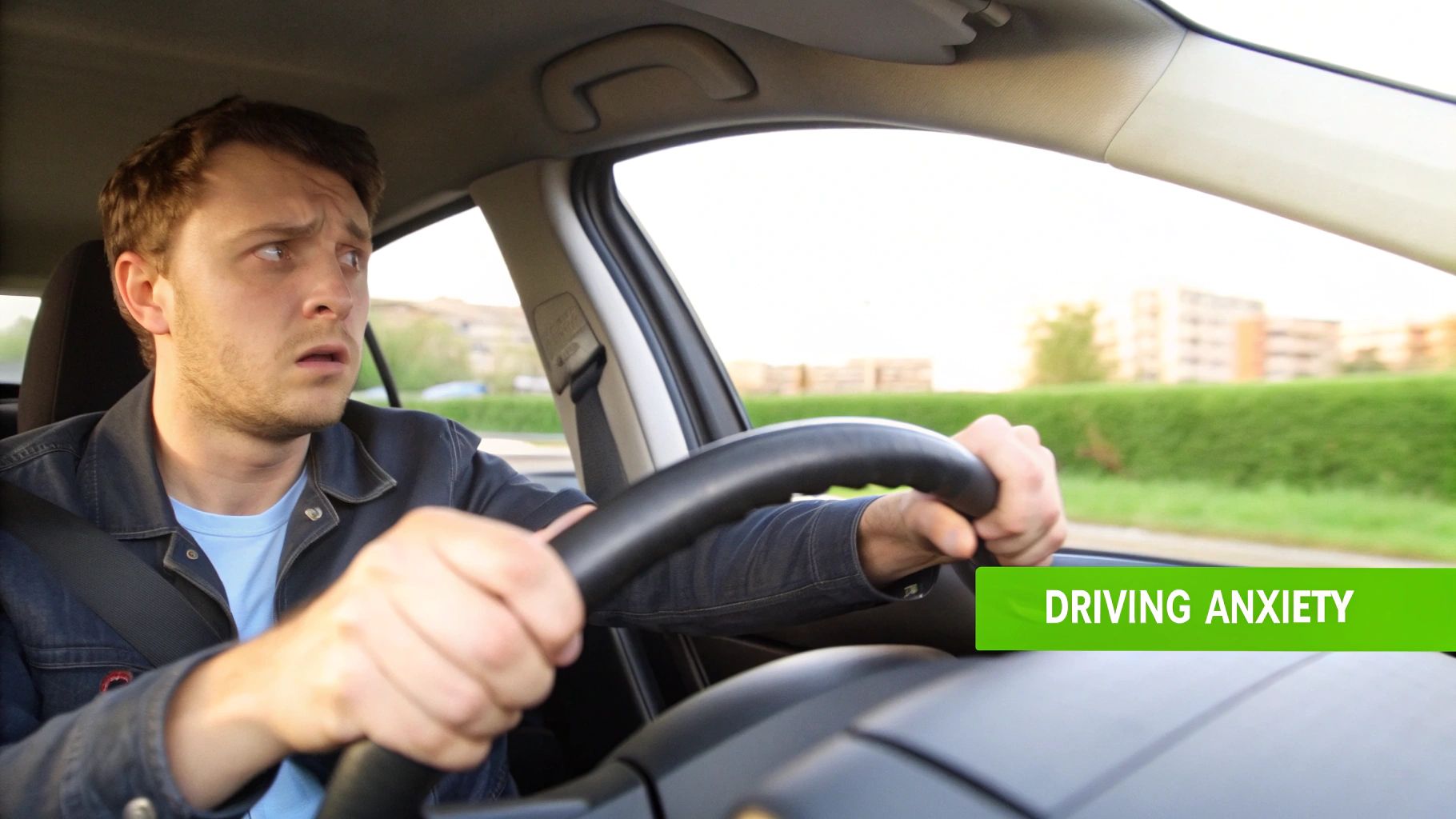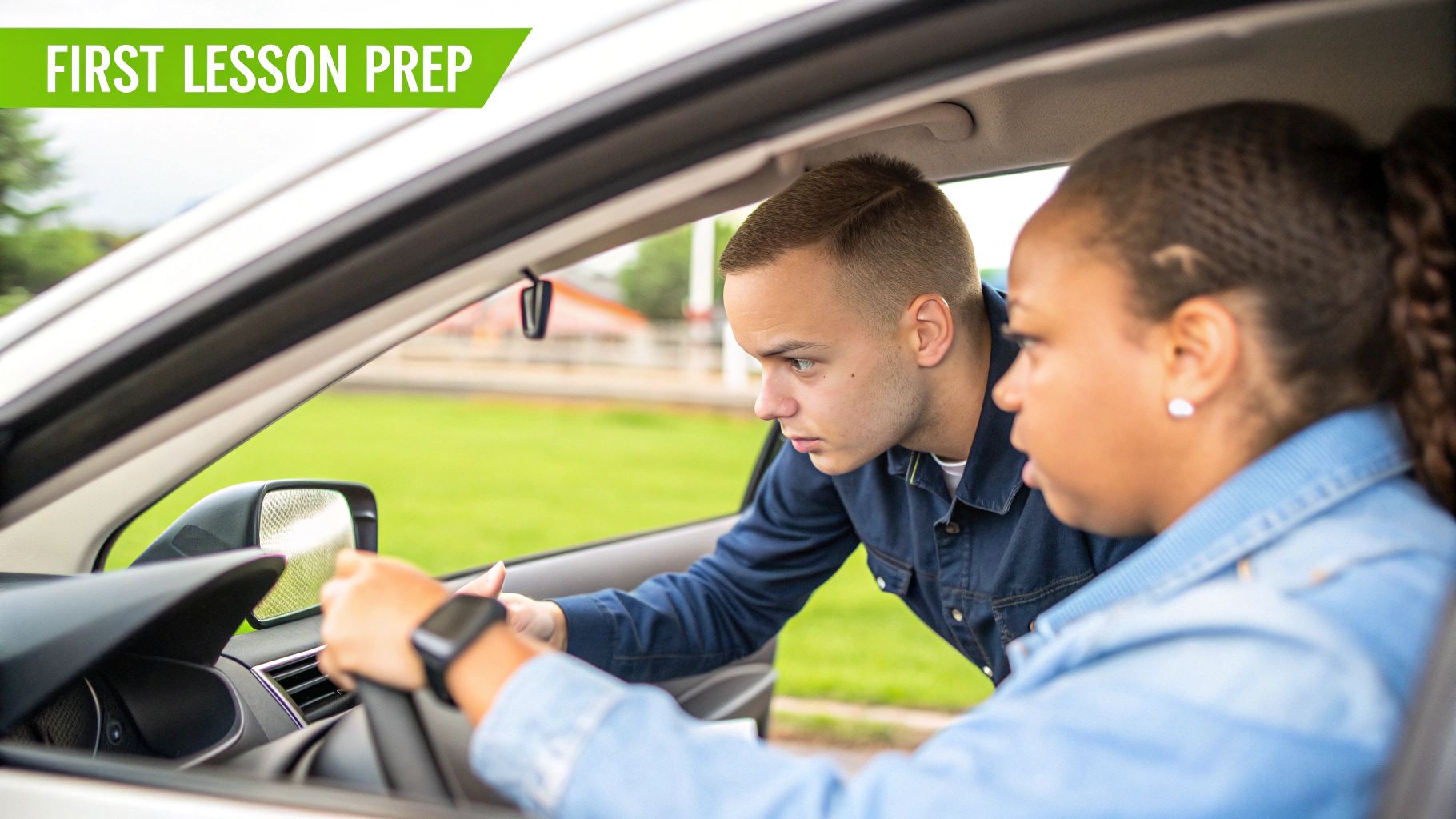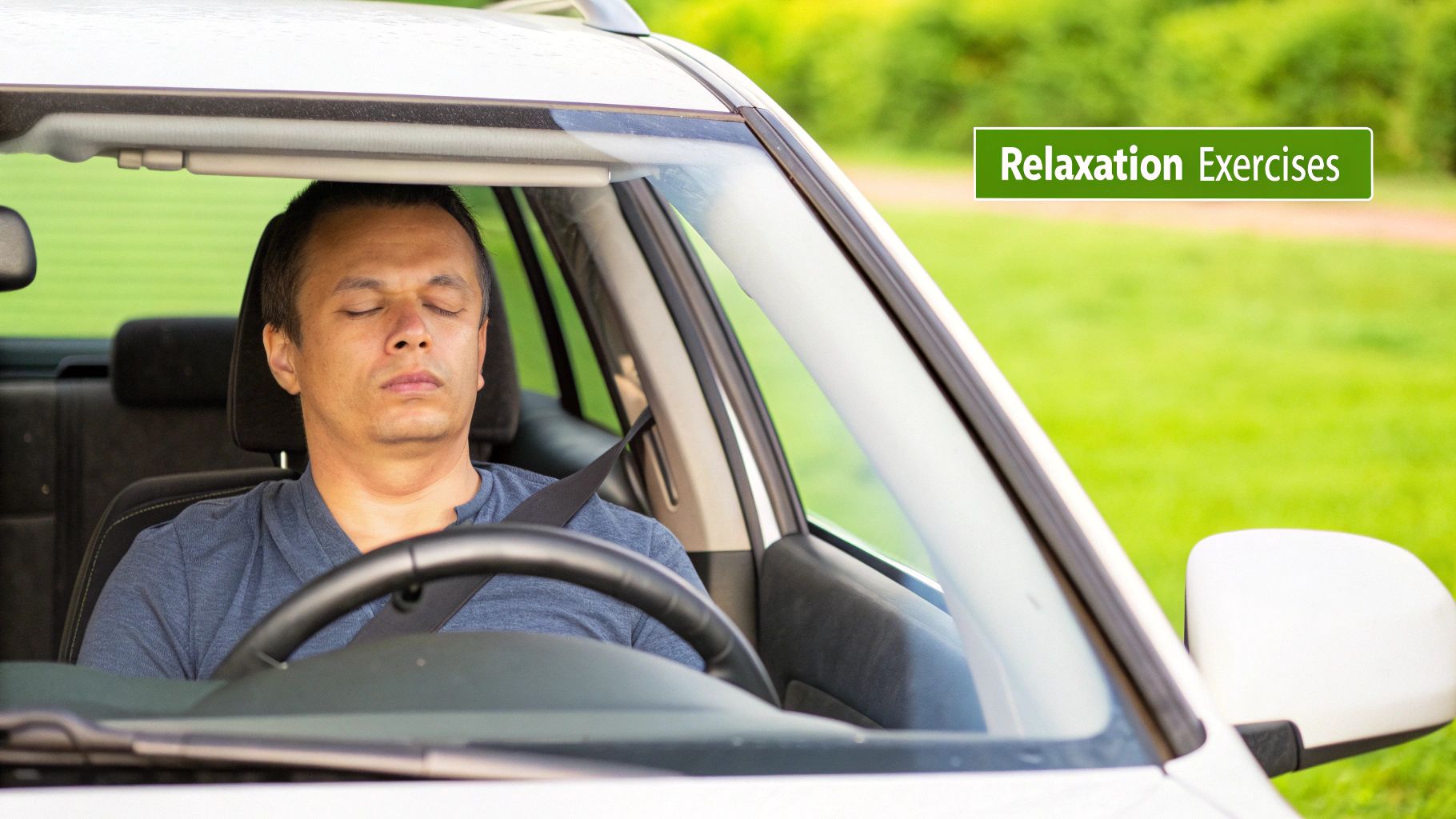When Your Heart Races Before You Even Start The Engine

Imagine this: you're ready for a driving lesson, keys in hand, but your heart is already pounding. This isn't just pre-lesson jitters. For many, driving anxiety can be truly overwhelming, turning a simple lesson into a monumental challenge.
This feeling is surprisingly common. It's your brain's natural "fight or flight" response misinterpreting the situation. Your brain perceives driving as a potential danger, even in the controlled environment of a driving lesson, and releases adrenaline. This leads to familiar physical symptoms: sweaty palms, shaky hands, a racing heart, and a knot in your stomach.
These physical symptoms are often accompanied by negative thoughts. These thoughts can range from “I’m going to crash” to “I’ll never be a good driver.” This negative self-talk fuels the anxiety, creating a difficult cycle to break. But understanding this process is the first step toward managing it. You might find this helpful: driving lessons for nervous drivers.
Understanding The Physical and Mental Components of Driving Anxiety
It’s helpful to think of driving anxiety as two interconnected parts: the physical and the mental. The physical symptoms are your body's reaction to the perceived threat. The mental component involves the negative thoughts and beliefs that feed the anxiety.
For example, a racing heart might trigger the thought, "I'm losing control," further intensifying the physical symptoms. This interplay between the physical and the mental is key to understanding how anxiety works.
Everyone's triggers are different. Some might be anxious about busy roundabouts, while others might fear motorway driving. Identifying your specific triggers is crucial for developing personalized coping strategies.
The Impact of Anxiety on Driving Test Performance
Research shows a clear link between anxiety and driving test performance. A 2006 UK study revealed that test anxiety can significantly impact performance on complex tasks like the driving test. Researchers found that those who failed their tests had higher heart rates and anxiety levels than those who passed. This highlights the importance of addressing anxiety during driver training. Discover more insights.
It's important to remember that this anxiety isn’t a sign of weakness. It often stems from a strong sense of responsibility and a desire to be a safe driver. It’s about learning how to channel this concern into confident, controlled driving.
By recognizing the root of your anxiety, you can start to develop the skills and strategies needed to manage it and reach your driving goals. This sets the stage for turning anxiety from an obstacle into a motivator, helping you become a safer and more confident driver.
The Science Behind Anxiety Driving Lessons That Actually Work

Forget the idea that anxiety driving lessons are just easier versions of regular lessons. They're a whole different ball game, designed to work with the way anxious minds learn and build confidence. It's about understanding how your thoughts, feelings, and actions connect when you're behind the wheel.
Understanding Your Anxiety Fingerprint
Think of an instructor creating a map of your personal "anxiety fingerprint." This initial talk goes way deeper than just your surface fears. It digs into your learning style, past driving experiences, and even how you like to communicate. Understanding how your body physically reacts to anxiety can be really useful. Check out this helpful article on Heart Rate Variability Chart. This deep dive lets the instructor build a learning plan just for you, one that avoids setting off your stress response.
Anxiety driving lessons also borrow techniques from sports psychology and therapy. For example, breathing exercises are woven into gear changes, and positive self-talk becomes second nature. These create what we call "safe challenge zones," allowing you to stretch your limits without triggering panic.
This personal touch is in everything. Instructors change their tone and teaching speed based on your feedback in the moment. The car becomes a safe space to learn and grow, not a pressure cooker. This approach is catching on across the UK. A 2024 survey showed that 79.7% of UK driving instructors offer specialized lessons for nervous drivers, costing between £36 and £40 on average. This shows a growing understanding of how important it is to address anxiety in driving instruction. Discover more insights.
Building Confidence, Not Just Competence
These lessons don't just teach you how to drive; they build confident competence, a mix of skill and emotional strength. It's like learning to dance: once you’re not fighting your nerves, you can focus on the steps. This leads to better hazard perception, smarter decisions under pressure, and sharper defensive driving skills.
This personalized method also helps you understand yourself better. By recognizing what triggers your anxiety and learning how to cope, you take control—not just of the car, but of your reactions. This often boosts your confidence in other parts of life too, creating a ripple effect beyond driving. Ultimately, anxiety driving lessons aren’t just about passing your test; they’re about giving you valuable life skills—managing stress, solving problems, and taking on challenges—that will empower you long after you get your license.
Why Anxiety Driving Lessons Create Better Drivers (Not Just Calmer Ones)

The infographic above illustrates how effective different anxiety-management techniques are during specialized driving lessons. These techniques include deep breathing exercises, adjusting your seat for optimal control, and using positive self-talk. Notice how deep breathing comes out on top, with a 70% satisfaction rate. Positive self-talk follows at 65%, and seat adjustments come in at 50%. This really underscores the power of incorporating mindful breathing into anxiety driving lessons.
Imagine trying to learn the piano while someone shouts in your ear. It’s hard to concentrate, right? Learning to drive with anxiety is similar – the constant worry makes it incredibly difficult to focus on developing the actual skills. Anxiety driving lessons create a calmer learning space, like a quiet practice room. This allows learners to truly absorb the process, build stronger driving skills, and become remarkably attentive drivers.
Confident Competence: The Goal of Anxiety Driving Lessons
The ultimate goal of these lessons isn’t just to dial down the anxiety; it's about building confident competence. Think of it as the perfect balance between technical skills and emotional resilience. A student might technically ace parallel parking, but anxiety can make it impossible to do it confidently in a real-life situation. Anxiety driving lessons help bridge that gap.
Students who participate in these programs often show improved hazard perception and make smarter choices under stress. They’re not simply less anxious; they're genuinely better prepared to navigate challenging situations. This creates stronger defensive driving instincts, resulting in safer drivers overall.
Let's look at how anxiety driving lessons differ from traditional lessons:
To understand the core differences, let's compare traditional driving lessons with lessons tailored for anxiety:
| Learning Element | Traditional Approach | Anxiety-Focused Method | Real-World Impact |
|---|---|---|---|
| Focus | Primarily skill acquisition | Skill acquisition + emotional regulation | Improved confidence and decision-making in stressful situations |
| Environment | Can be stressful due to performance pressure | Supportive and understanding, minimizing pressure | Increased comfort and focus during lessons |
| Techniques | Standard instruction on rules and maneuvers | Personalized instruction incorporating anxiety management strategies (breathing, mindfulness) | Better hazard perception and quicker response times |
| Feedback | Corrective and instructive | Encouraging and confidence-building | Fosters a positive learning experience and promotes self-belief |
This table highlights how anxiety-focused lessons go beyond just teaching the rules of the road. They equip learners with the mental and emotional tools to handle the real-world pressures of driving.
Beyond the Driving Seat: Life Skills Learned Through Anxiety Management
The positive effects of these lessons go far beyond driving. Overcoming driving anxiety can significantly boost confidence in other areas, like public speaking or job interviews. This is because the lessons equip students with valuable transferable skills.
These lessons teach you to break complex problems into manageable steps. They also give you the tools to effectively handle stress. This means the problem-solving and stress-management skills you develop become valuable assets you can apply to various aspects of your life, long after you've passed your driving test. The focus on celebrating small wins builds resilience and self-belief, qualities that are invaluable in any challenging endeavor.
Your First Lesson: What Really Happens (And Why It's Nothing Like You Expect)
Let's face it, that knot in your stomach just thinking about your first anxiety driving lesson is perfectly normal. But here's the surprising truth: most learners are amazed by how much easier, even enjoyable, that initial session actually is. Think of it like testing the water with your toes before jumping into a pool.
The First Contact: Sharing Your Worries (And Weird Fears)
Right from the first phone call, anxiety driving lessons are designed differently. You're encouraged to share every single worry, no matter how trivial or unusual it might seem. It's not about pretending you're fearless; it's about acknowledging your anxieties so you and your instructor can build a plan together. This open communication creates a supportive atmosphere where your feelings are validated, not brushed aside.
The Initial Consultation: More Than Just "What Scares You?"
The consultation is a key part of these specialized lessons. It goes much deeper than a quick "What are you afraid of?" It’s a detailed exploration of your learning style, past driving experiences, and even how you prefer to communicate. This in-depth discussion helps your instructor understand your individual needs and create lessons that truly fit you. This personalized approach builds trust and comfort right from the beginning.
Sitting Still: Learning the Controls Without the Pressure of Movement
You might be surprised to learn that you could spend a good chunk of your first lesson just sitting in a parked car. This gives you time to get familiar with the controls—steering wheel, pedals, gears—without the added stress of moving. It’s like learning the notes on a piano before trying to play a song. This reduces initial anxiety and creates a solid base for when you do start driving. Instructors are trained to notice even small cues—your breathing, how you sit, your hand movements—to understand your comfort level. They'll adjust their teaching based on these observations, making sure you progress at a pace that feels right for you.
Small Steps, Big Wins: Building Confidence Brick by Brick
Anxiety driving lessons focus on gradual progress. You might begin by simply starting the car, then practicing steering while stationary, and eventually venturing out onto quiet streets. These small successes build confidence and demonstrate that you can handle each step. This incremental approach is key to changing how your brain reacts to driving, replacing fear with a growing sense of competence. Many students finish their first lesson thinking, "I can actually do this!" This shift in perspective, from apprehension to optimism, is the core of successful anxiety driving lessons. It sets the stage for continued learning and progress in future sessions.
How Fast Pass Reads Your Anxiety Like a Roadmap

At Fast Pass, we get that anxiety isn't one-size-fits-all. It's personal, shaped by your experiences and how you learn. Think of an instructor who not only teaches you the rules of the road but also understands your specific anxieties and adjusts their teaching style accordingly. That’s the Fast Pass difference.
Beyond the Questionnaire: Understanding Your Anxiety Landscape
Our assessments go beyond simple questionnaires. We don't just ask if you're nervous; we explore the reasons behind your anxiety. This involves discussing past experiences, pinpointing triggers, and even understanding your preferred communication style. This lets us build a personalized learning plan just for you. For example, are you a visual learner who thrives on demonstrations? Or a kinesthetic learner who learns best by doing? Understanding these details is key to our approach.
It’s also important to recognize that mental health challenges are increasingly common among young drivers. NHS Digital reports that 1 in 4 young people aged 17 to 19 in the UK had a probable mental disorder in 2022. This highlights the need for driving instructors who can support learners with anxiety. The government's "Ready to Pass?" campaign acknowledges that nerves are normal, but emphasizes the importance of managing them for safe driving and test success. You can learn more about the government's perspective on learner anxiety here. This focus creates a more supportive learning environment.
Flexible Lessons: Adapting to Your Pace and Progress
Our anxiety driving lessons are all about flexibility. We understand that your comfort levels and energy can change from day to day. So, we adapt our lessons in real-time, adjusting the pace and content based on your needs. Your feedback isn't just welcome; it’s essential. As your confidence grows, we’ll increase the challenge, ensuring a constantly evolving learning experience. This keeps you learning at a pace that feels right for you, building confidence every step of the way.
Personalized Learning Journeys: From Parking Lots to Motorways
Our personalized approach shapes individual learning journeys. Take, for instance, the learner who needed three weeks practicing in empty car parks before venturing onto the road. Or the student who overcame motorway anxiety through gradual exposure, starting with quiet slip roads and progressing to busier highways. These examples show how we tailor lessons to specific needs and challenges. We don't believe in a one-size-fits-all method. We create a roadmap specifically designed for you.
Between-Lesson Support: Maintaining Momentum and Confidence
Our support doesn’t end when the lesson does. We know maintaining momentum and confidence between sessions is critical. We provide resources and techniques to help you manage anxiety even when you're not in the driver's seat. This ongoing support reinforces what you learn during lessons, promoting lasting confidence. It's a holistic approach that ensures your learning continues throughout your driving journey.
Your Anxiety Toolkit: Techniques That Work When You Need Them Most
Learning to drive with anxiety isn't about erasing fear entirely. It's more about building a skillset to manage it effectively. Think of it like assembling a personalized toolkit, packed with different techniques you can pull out depending on the situation. These are practical, real-world strategies for navigating those tricky driving moments.
Breathing and Relaxation: Your In-Car Calming Techniques
Sometimes, the simplest solutions are the most powerful. The 4-7-8 breathing technique, for example, is something you can use discreetly anywhere, even while waiting at a red light. Breathe in for a count of four, hold for seven, and exhale slowly for eight. It’s a quick way to regulate your breathing and soothe your nervous system.
Another effective method is progressive muscle relaxation. While keeping your hands safely on the wheel, try tensing and releasing different muscle groups. Start with your toes and gradually work your way up your body. This helps to release physical tension, which is a very common symptom of anxiety.
Ever feel like your mind is racing a mile a minute? Grounding techniques can help bring you back to the present moment. Focus on what you’re experiencing with your senses: what you see, hear, feel, and smell. This helps interrupt those anxious thoughts and anchors you in the here and now.
Mental Strategies: Rewiring Your Inner Dialogue
Our thoughts have a powerful impact on how we feel. Visualization involves mentally rehearsing challenging driving scenarios, like navigating a roundabout or merging onto the motorway. By picturing yourself successfully handling these situations, you can build confidence and reduce anxiety when you encounter them in real life.
We all have that inner critic, but learning to manage anxiety involves cultivating a more supportive inner voice. Positive self-talk is about replacing negative thoughts with encouraging ones. Instead of thinking, "I can't do this," try, "I'm learning, and it's okay to make mistakes." This simple shift in perspective can dramatically boost your self-belief.
A little preparation can go a long way. Establishing pre-lesson routines can set a positive tone before you even start the car. This might include listening to calming music, practicing deep breathing, or reviewing your successes from the previous lesson. Creating a calming ritual can help instill a sense of control and reduce pre-lesson jitters. For more pre-driving relaxation tips, check out our guide on how to relax before your driving test.
Communication and Reflection: Making the Most of Your Lessons
Open communication with your instructor is key. Don't hesitate to let them know when you're feeling anxious. They're trained to support you through these moments and can adapt the lesson as needed. This open dialogue creates a safe and supportive learning environment.
Taking time for post-lesson reflection is also valuable. Think about what you accomplished during the lesson, no matter how small. Acknowledging even the smallest victories reinforces your learning and builds confidence for your next session. This ongoing reflection helps solidify your skills and helps you maintain a positive outlook on your progress.
Before we move on, let's take a look at some specific techniques you can apply to common driving challenges:
Anxiety Management Techniques for Every Driving Scenario
A comprehensive guide showing specific anxiety management techniques matched to common driving situations that trigger nervousness
| Driving Challenge | Anxiety Response | Proven Technique | Success Indicator |
|---|---|---|---|
| Merging onto a busy motorway | Racing heart, shallow breathing | 4-7-8 breathing, positive self-talk ("I can do this, I've practiced this") | Smooth, controlled merge without hesitation |
| Approaching a roundabout | Feeling overwhelmed, indecisive | Visualization, pre-lesson planning of route | Confidently navigating the roundabout, choosing the correct lane |
| Parallel parking | Tense muscles, negative thoughts ("I'll never get this right") | Progressive muscle relaxation, grounding techniques (focus on the feel of the steering wheel) | Successful parallel park within a reasonable timeframe |
| Driving in heavy traffic | Feeling trapped, irritable | Deep breathing, grounding techniques (focus on the sounds of the traffic) | Maintaining a calm demeanor, responding appropriately to traffic flow |
| Night driving | Reduced visibility, increased anxiety | Visualization (imagining a clear path), communicating concerns with instructor | Comfortable and controlled driving in low-light conditions |
This table provides a starting point. As you gain experience, you can add your own personalized techniques and success indicators.
Remember, these techniques aren't magic fixes, but they are powerful tools. The key is to experiment and discover what works best for you. Consistent practice makes all the difference. By building your anxiety toolkit and using it regularly, you'll transform anxiety from a roadblock into a stepping stone on your journey to becoming a confident driver.
From Anxious To Confident: Your Practical Action Plan
You've explored driving anxiety, the science behind effective lessons, and some helpful techniques to manage those nerves. Now, let's map out your personalized route to driving freedom. This isn't simply about scheduling lessons; it's about crafting your unique journey from anxiety to genuine confidence behind the wheel.
Choosing The Right Instructor: Your Partner In Confidence
Finding the right instructor is like choosing the right climbing partner for a challenging ascent. They are your guide, mentor, and confidant throughout this journey. Look for someone with a proven track record of helping anxious learners. Don't hesitate to ask specific questions during the initial consultation, such as:
- "What's your approach to working with anxious learners?"
- "Can you share stories of how you've helped other anxious students?"
- "How do you adjust lessons based on individual needs and comfort levels?"
Be wary of red flags like dismissing your concerns or rushing you. The right instructor will listen patiently, validate your feelings, and create a supportive learning environment where you feel safe to learn at your own pace.
Preparing For Your First Lesson: Setting Yourself Up For Success
Think of your first lesson as dipping your toes into the water, not diving headfirst. It's about building rapport and establishing trust with your instructor. Practical preparation is key, too:
- Comfortable Clothing: Wear what makes you feel relaxed and at ease. Restrictive clothing can add unnecessary tension.
- Mental Preparation: Picture yourself successfully handling the car, navigating roads smoothly, and enjoying the experience. Visualization can be a powerful tool.
- Open Communication: Frankly discuss your anxieties with your instructor. The more they understand your concerns, the better they can provide tailored support.
Check out our guide on driving tips for beginners for additional helpful advice. Having a toolkit of practical strategies is essential. You can find a helpful anxiety coping skills PDF.
Setting Realistic Goals And Tracking Your Progress
Learning to drive is like learning any new skill; progress isn't always a straight line. There will be good days and more challenging days. Setting realistic milestones helps prevent feeling overwhelmed. Break your learning journey into small, digestible steps:
- Mastering the Basics: Concentrate on getting comfortable with the controls, starting and stopping smoothly, and basic maneuvers.
- Gradual Exposure: Begin on quiet, less-trafficked roads and gradually work your way up to busier streets and more complex driving situations.
- Celebrating Wins: Acknowledge and appreciate every step forward, no matter how small. This positive reinforcement is crucial for building confidence.
Maintaining Motivation And Handling Setbacks
Encountering plateaus in your learning is normal. Don't be discouraged if your progress slows down. It's a natural part of the process. Here's how to stay motivated:
- Focus on Your "Why": Remember your reasons for wanting to learn to drive. What will this newfound freedom and independence mean for you?
- Seek Support: Talk to your instructor, friends, or family about your challenges. Sharing your feelings can lighten the burden.
- Practice Self-Compassion: Be kind to yourself. Learning to drive takes time and effort. Don't dwell on mistakes; learn from them and move forward.
Transitioning To Independent Driving And Beyond
As your confidence grows, you'll gradually feel more comfortable taking charge of your driving journey. Here are some tips for a seamless transition to solo driving:
- Practice in Familiar Environments: Start driving in areas you already know well. This reduces anxiety and lets you focus on honing your skills.
- Gradually Increase Driving Time: Begin with short trips and gradually increase the duration and distance as your confidence grows.
- Develop a Post-Test Plan: Consider how you’ll maintain and build upon your skills after passing your test. Think about advanced driving courses or regular practice to solidify your abilities.
Overcoming driving anxiety is more than just getting a license; it's about unlocking a new level of freedom and independence. Ready to embark on this journey? Visit Fast Pass Driving Courses and let us help you navigate your path from anxious to confident.

